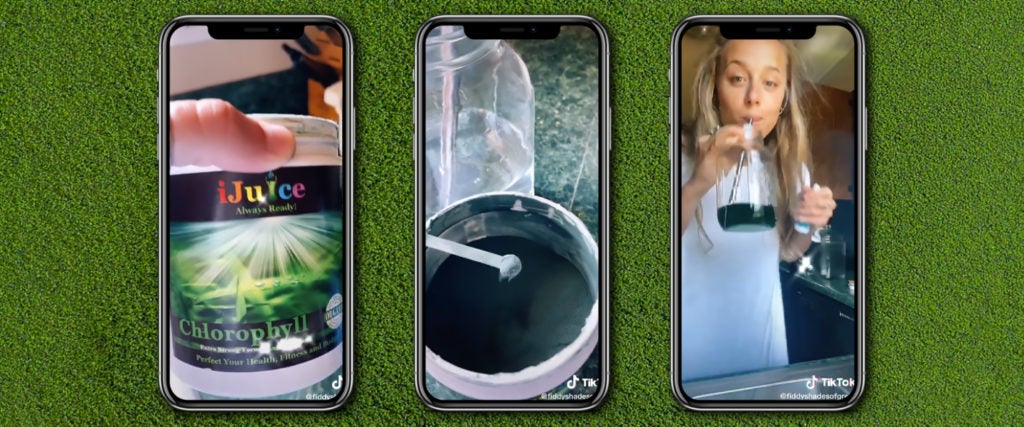Skin looking dull? Liver needing detoxing? Vibes off? Vibrational frequency out of tune? Well drink some photosynthetic pigment, you stupid bitch.
On TikTok, people are recommending chlorophyll for tons of reasons, saying it promotes general detoxification, clear skin and “makes [their] cells so stoked.” It’s pretty harmless — if you eat green veggies, you eat chlorophyll — but its actual benefits are debatable. Besides giving your water a cool swamp color, what can a chlorophyll supplement actually do?
@fiddyshadesofgreen “makes my cells SO STOKED” #morningroutine #cbd #chlorophyll #alkaline #mudwtr #appalachianstandard
Like many other popular natural supplements of the earthy-crunchy variety, there aren’t a ton of conclusive scientific studies exploring the effectiveness of chlorophyll. This isn’t to say it can’t improve your skin or give you a boost of energy, just that it hasn’t been proven by medical standards.
There are, however, a few things chlorophyll has been proven to do. According to Oregon State University’s Micronutrient Information Center, a semi-synthetic version of chlorophyll called chlorophyllin has most widely been used as a form of “internal deodorant.” Administered orally to patients with colostomies or ileostomies (a surgery similar to a colostomy, but in the small intestine), chlorophyllin reduced fecal odor. Similar studies have found comparable effects in incontinence patients. Topical chlorophyllin has also had odor-reducing effects on wounds, and may help promote healing.
Obviously, those benefits aren’t quite applicable to the average person. Other studies, however, show that chlorophyll and chlorophyllin might help slow cancer growth and reduce the risk of lung, colon and liver cancer, but they’ve only been conducted using rats and mice. Still, this research has demonstrated chlorophyll/chlorophyllin’s ability to bind with carcinogens and prevent them from reaching susceptible tissue, pointing to some potential effectiveness in humans.
@pullingraviity Drink for glowing skin pt.1 #glowingskin #skincaretips #skincare #wellness #skintips #clearskin #acnehelp #selfcare #antiaging #fyp #viral #trippy
As for everything people are promoting on TikTok, there’s just not yet the data to support the idea that the average person will notice improvements in health from consuming chlorophyll, or rather, more chlorophyll — most chlorophyll supplements (which actually contain chlorophyllin themselves, derived from alfalfa and sodium copper) offer around 100 milligrams of chlorophyll per one tablespoon dose, which is a similar amount of chlorophyll to what you’d already get from eating four cups of spinach. But there’s no data to say it’s dangerous, either, though it might make your pee green.
Chlorophyll supplements aren’t too expensive — a 32-serving bottle goes for $10 online. There are also super bougie versions going for $39 for 30 servings, if you want to be a sucker. It’s your call either way if you want to consume chlorophyll — worst-case scenario, nothing really happens to you.
@anomalkingdom Please do your own research. #432hz #528 #528hz #frequency #Entrepreneur #spiritual #wakeup #1111 #333 #conspiracy #5d #love #blowthisup
Beyond consuming it, there’s also a popular TikTok going around with more than 300,000 likes claiming that you should-not listen to 432 hz music, as is commonly featured in meditation videos as a “healing frequency” on YouTube. Instead, the creator says that you should listen to 528 hz, “the resonant frequency of love, and the resonant frequency of chlorophyll.” According to the website Natural Healing Society, 528 hz vibrations allow plants to “draw some energy from natural light, which gives the leaves the green color. Bees are an essential aspect of insect-pollinated flowers. The bees pollinate the flowers by buzzing at a 528 hz frequency… The breathable air is made up of 528 hz. Oxygen is a carrier of the 528 hz resonating electrons.”
There’s little other information available about whether this connection between vibrational frequencies and chlorophyll is true, so interpret that how you will. Nevertheless, chlorophyll is indeed responsible for photosynthesis and does basically support all life on earth, by that measure. If that type of thing makes you feel good and has you wanting to consume chlorophyll (or listen to the alleged frequency of chlorophyll), well, more power to you.

